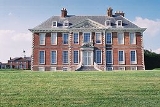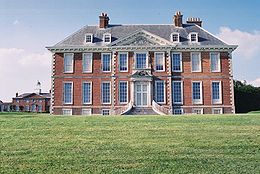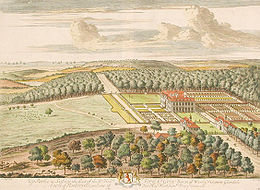
Uppark
Encyclopedia


South Harting
South Harting is a village in the Chichester district of West Sussex, England. It lies within the civil parish of Harting. The village sits on the B2146 Road four miles southeast of Petersfield, Hampshire....
, Petersfield
Petersfield, Hampshire
Petersfield is a market town and civil parish in the East Hampshire district of Hampshire, England. It is north of Portsmouth, on the A3 road. The town has its own railway station on the Portsmouth Direct Line, the mainline rail link connecting Portsmouth and London. The town is situated on the...
, West Sussex
West Sussex
West Sussex is a county in the south of England, bordering onto East Sussex , Hampshire and Surrey. The county of Sussex has been divided into East and West since the 12th century, and obtained separate county councils in 1888, but it remained a single ceremonial county until 1974 and the coming...
, England
England
England is a country that is part of the United Kingdom. It shares land borders with Scotland to the north and Wales to the west; the Irish Sea is to the north west, the Celtic Sea to the south west, with the North Sea to the east and the English Channel to the south separating it from continental...
and a National Trust
National Trust for Places of Historic Interest or Natural Beauty
The National Trust for Places of Historic Interest or Natural Beauty, usually known as the National Trust, is a conservation organisation in England, Wales and Northern Ireland...
property.
The house, set high on the South Downs
South Downs
The South Downs is a range of chalk hills that extends for about across the south-eastern coastal counties of England from the Itchen Valley of Hampshire in the west to Beachy Head, near Eastbourne, East Sussex, in the east. It is bounded on its northern side by a steep escarpment, from whose...
, was built for Ford Grey
Ford Grey, 1st Earl of Tankerville
Ford Grey, 1st Earl of Tankerville , 1st Viscount Glendale, and 3rd Baron Grey of Warke, was a British nobleman and statesman. He was the son of Ralph Grey, 2nd Baron Grey of Werke and Catherine Ford, daughter of Sir Edward Ford of Harting in West Sussex. He was baptized the day of his birth at...
(1605—1701), the first Earl of Tankerville, c. 1690 and was sold in 1747 to Sir Matthew Fetherstonhaugh
Sir Matthew Fetherstonhaugh, 1st Baronet
Sir Matthew Fetherstonhaugh, 1st Baronet FRS pronounced "fan-shaw" was an English politician and landowner.He was the son of Matthew Fetherstonhaugh of Featherstone Castle, Northumberland. In 1746 he inherited the estates of a kinsman Sir Henry Fetherston but not Sir Henry's baronetcy which became...
and his wife Sarah. Matthew and Sarah redecorated the house extensively from 1750 to 1760 and introduced most of the existing collection of household items displayed today, much of it collected on their Grand Tour
Grand Tour
The Grand Tour was the traditional trip of Europe undertaken by mainly upper-class European young men of means. The custom flourished from about 1660 until the advent of large-scale rail transit in the 1840s, and was associated with a standard itinerary. It served as an educational rite of passage...
of 1749 to 1751. Their only son, Sir Harry Fetherstonhaugh, added to the collection and commissioned Humphry Repton
Humphry Repton
Humphry Repton was the last great English landscape designer of the eighteenth century, often regarded as the successor to Capability Brown; he also sowed the seeds of the more intricate and eclectic styles of the 19th century...
to add a new pillared portico, dairy and landscaped garden. In the 19th century stables and kitchens were added as separate buildings connected to the main building by tunnels.
On 30 August 1989 the building was devastated by a fire caused by a workman's blowtorch whilst repairing lead flashing on the roof, just two days before the work was due to be completed. The fire broke out during opening hours. Many works of art and pieces of furniture were carried out of the burning building by members of the Meade-Fetherstonehaugh family, National Trust staff and members of the public. Although the garret and first floors collapsed onto the lower floors and the garret and first floor contents were lost completely, the floors largely fell clear of the ground floor walls and much of the paneling and decoration survived. Much of the contents of the ground floor was crushed but not burned; metalwork was able to be straightened and cleaned, crystal chandeliers were able to be reassembled, and even the elaborate tassels on the chandelier ropes were able to be conserved. The decision to restore the house came after it was determined that restoration would be a cheaper insurance settlement than complete payout for a total loss.
Most of the pictures and furniture in the house were saved. The building has since been completely restored with many lost crafts relearned in the restoration process, and it re-opened its doors in 1995.
H.G. Wells spent part of his boyhood at Uppark, where his mother was housekeeper between 1880 and 1893.

